 [This is the second of a pair of related columns I published in Camera & Darkroom magazine in 1994. Click here for part 1.
[This is the second of a pair of related columns I published in Camera & Darkroom magazine in 1994. Click here for part 1.
Originally called Darkroom Photography, in January of 1991 this monthly magazine changed its name to Camera & Darkroom Photography and, sometime thereafter, shortened that to Camera & Darkroom. You’ll find the backstory of my involvement with this publication in the note at the beginning of the previous installment.
For my ruminations on the typewriter as a tool, click here.
This article first appeared in my “Depth of Field” column in Camera & Darkroom, issue 16:8, August 1994. You’ll find it reprinted in my 1998 collection of essays, The Digital Evolution: Visual Communication in the Electronic Age. — A.D.C.]
•
An Arranged Marriage:
My Life with the Computer
In my last column, I acknowledged my sympathies with those photographers who are less than thrilled with the accomplishments to date of those who produce electronic imagery, and who remain skeptical about the impact of these new technologies on the craft of photography. Now I want to indicate my empathy with those photographers who have an actual fear and loathing of these suddenly omnipresent tools and processes that seem to be rapidly taking over the medium. I understand what you’re going through; it’s exactly parallel to what I’ve experienced as a working writer, and I want to address the situation from that standpoint.
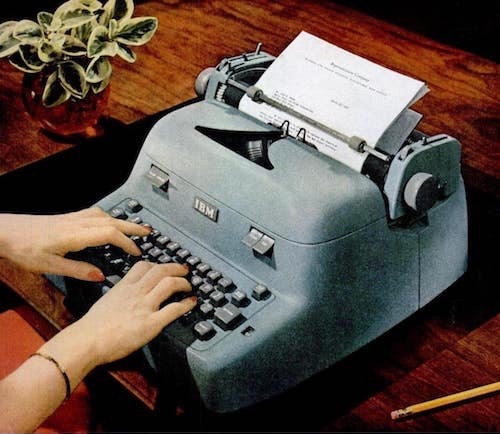
IBM electric typewriter ad, ca. 1951
As a professional wordsmith, I hated the whole idea of writing on a computer from the beginning. Not that I was a Luddite, devoted to the literal manuscript, by any means. I grew up around typewriters: not just manual ones, but even more serious writing machines — those hulking, tank-like post-World War Two IBM electrics. They were the first pieces of machinery I ever came to love.
By the time I got to college it had become second nature to sit down at the typewriter to work out an idea. A sleek dull-green manual Olivetti portable was the first I ever bought, finely designed and compact, the writer’s equivalent of a 1950s rangefinder Leica.
When I graduated from college in 1964, with a B.A. in English, and headed off to do graduate work in literature and creative writing, my mother asked me what I wanted for a present. “An electric typewriter,” I answered immediately, Smith-Corona having just produced its first portable model. And that’s what she gave me. This wasn’t that much of a change, roughly comparable to the first experience of working with a built-in metering system. A few years later I started earning my living as a working writer on it.
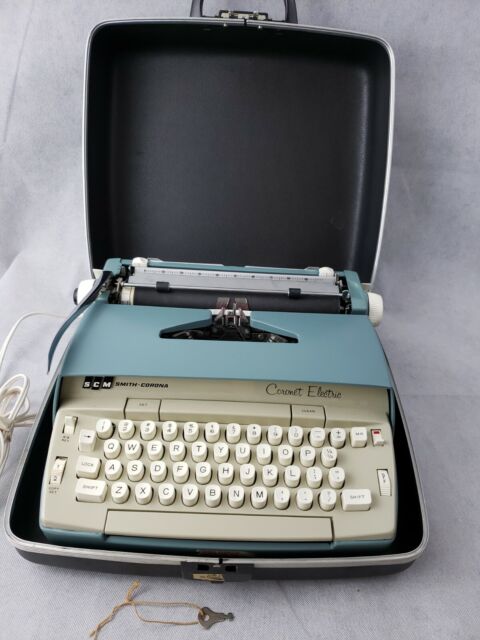
1960s Smith-Corona Coronet Electric 6SV Series typewriter
•
For the next two decades I traded up every five years or so; like camera manufacturers, typewriter companies periodically add new bells and whistles. (There was the automatic carriage return, the typo correction cartridge, the changeable typeface ball …) Basically, however, the instrument remained the same; the user never had to rethink his or her fundamental relationship to the tool. In this sense, photography and writing were in pretty much the same boat from World War II through the decade after Vietnam.
Then, in the early 1980s, “word processing” began to be discussed, and various crude instruments therefor came on the market. I could tell this was the future of my profession, and I found it hateful. I’d never been much for television, and this promised to be like watching myself writing on TV. Even the term “word processor” was repellent; it sounded like something you’d use to make verbal sausage. I committed myself to holding out.
•
One day in 1981 there came a knock on my door. I opened it to find a postman named Aaron Farr, who was, it turned out, a serious amateur photographer. He’d recognized my name on the mail he was delivering, and decided he wanted to meet me. Aaron was also seriously interested in computers. I don’t know if he’d qualify as a hacker, but he was fooling around with an early Texas Instruments model and doing some elementary programming. He invited me over to his house one day and gave me a tutorial. It was my first direct encounter with word processing. I didn’t exactly take to it, but it seemed — intriguing. In any case, I could no longer say I’d never tried it.
By mid-1987, editors were beginning to ask if I could make my texts available to them on floppy diskette. The inevitable moment had come. I forced myself to address this new technology by ensuring that a large quantity of my work would be converted to text files on floppy diskettes, an act roughly equivalent to entering into an arranged marriage. There ensued perhaps the most stressful period of my working life as a professional: three agonizing, extremely frustrating months in which every free hour of my time — often eight to twelve hours of a day — was devoted to finding my way into this technology.
Inevitably, there were system crashes. Sometimes an entire file would simply vanish into cyberspace (which, as I came to understand it, is the computer version of that parallel universe inhabited by all your missing socks). Occasionally, late at night in the computer lab at the university where I taught, I’d find myself weeping, or screaming, or pounding the desk in rage.
 Then, quite suddenly, to my astonishment, I came out the other side, happily and confidently working away in WordPerfect, which continues to be my word processor of choice. Somehow, I’d come to terms with the first radical transformation of my medium that had ever confronted me.
Then, quite suddenly, to my astonishment, I came out the other side, happily and confidently working away in WordPerfect, which continues to be my word processor of choice. Somehow, I’d come to terms with the first radical transformation of my medium that had ever confronted me.
Two months after that I had my first computer. Everything I’ve written since then (including everything of mine you’ve read in these pages), even if it started out as a hand-written draft, has been put through the computer; I can hardly imagine working without it now, and cannot figure out why I waited so long to engage with it.
•
Mind you, I’m no computer maven, nor even a word-processing whiz. I use my computer mainly as a fancy electric typewriter with built-in scissors and paste, white-out, and vast memory. I don’t say this proudly; I know I’m ignoring some of what this technology could contribute to my productivity, and plan to attack this self-limitation soon. At the same time, I’m more than willing to acknowledge that, even at this primitive stage, I can’t imagine getting along without the computer; it’s changed my life as a working writer, and has even, in some ways that I sense but can’t specify, changed my writing.
And yes, I still consider myself a writer, and call what I produce writing, even though my former blank page has been replaced by a screen, and my prose has become plastic, malleable and provisional in a way it never was when, by hand or by typewriter, I used to imbed words physically in the fibers of paper. (Am I obligated to give it some other name — “electronic wording,” perhaps?)
In any case, I can’t really claim to have taste-tested the full range of the computer’s potential improvement of my life. So when the beauteous and brilliant Brenda Laurel (who devised the home version of Pac-Man) announced to a packed house at the Eastman Theater in Rochester last July that “Computers are devices not just for computation but for representation — they allow us to re-present all kinds of things and issues to ourselves,” I had to take that assertion on faith. Almost. But not entirely.
•
You see, back when I was in graduate school, circa 1965, I wrote a peculiar, pre-“cyberpunk” experimental fiction titled “postscript” that was intended as a cross between a lunatic’s ravings and an account of a post-apocalyptic world. I meant it to be heard in the reader’s mind as coming from a flat, affectless, virtually robotic voice; I used certain punctuation mannerisms to indicate this. But no one I ever showed it to heard it as I’d intended. By and by, I realized that it was a sound piece, meant for the ear and not the eye. But I couldn’t figure out any way of getting it onto audiotape that wasn’t unbearably laborious. So I shelved it as a failed experiment.
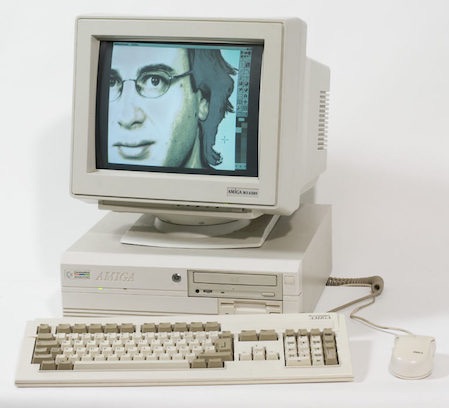
Amiga 4000, ca. 1992
Then, a few years ago, a colleague of mine in Cleveland, the photographer and teacher Masumi Hayashi, was describing to me some electronic imaging work she was doing on an Amiga system. In passing, she mentioned that the Amiga “Talker” program she’d gotten bundled with her software would allow the computer to recite an electronically encoded text, in a variety of voices: male, female, and “robotic.” My ears perked up; I remembered my failed experiment. I dug out the text and had it scanned onto diskette, in ASCII. A few months later, I bought a cheap round-trip ticket to Cleveland, spent a weekend in her studio, and produced a computer-narrated version of my fiction, on audiotape.
As soon as I heard the first few words come out of the computer’s speaker, I knew that this was the way the work was supposed to be experienced; this was what I’d heard in my own head when I was writing it twenty years before. It was a very young piece of writing, and far from perfect; but it had, at last, found its appropriate form.
•
The simple fact is that, for any creative person who engages with it seriously, the computer makes feasible things that couldn’t have been done before — either because they were impossible or because they were too labor-intensive to be worthwhile. Even a disgruntled creature of habit like myself, an old dog who’s just crossed the half-century mark, can learn new tricks, can at least test this tool for its potential contribution to his or her working process.
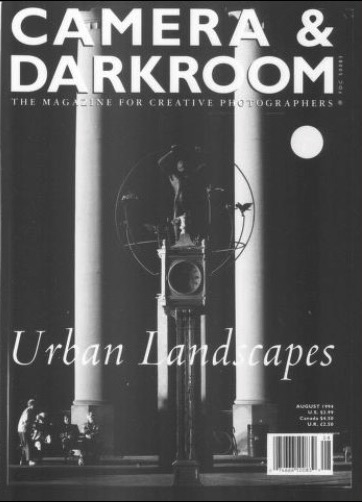
Camera & Darkroom, August 1994 (cover)
Changes in the tools, materials and processes of any medium are traumatic for some of its practitioners. The great British architectural photographer Frederick Evans stopped photographing when the commercial production of platinum paper was discontinued early in this century; he couldn’t — or didn’t care to — actualize his way of seeing in silver. The shift from manuscript to typescript, though rarely investigated or even discussed in terms of its impact on literature, was both a shocking and a shaping experience for several generations of writers a century ago; the transition from one-of-a-kind images to multiples, and from hand-drawn images to lens-derived ones, was equally transformative and has been much more widely analyzed. There’s no question that the shift to word processors and electronic imaging systems will be such a watershed in our day, for writers and picture-makers alike.
Be there or be square, I say. Put your fear and loathing on hold; approach this set of options with an open mind. Take a look at the fascinating experiments that are being run by serious photographers like Pedro Meyer, Joan Fontcuberta and others (parallel investigations are being undertaken by such writers as William Gibson.) In particular, I’d advise you to reconsider, in the light of these new technologies, any photographic projects of your own that you’ve shelved as unfeasible; you may find, as I did, new options at your disposal. (For example, I’m convinced that there are extraordinary potentials here for new, inexpensive ways of structuring, encoding, transmitting and disseminating documentary and photojournalistic image-text works.)
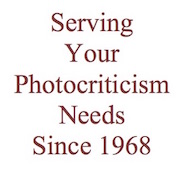 There’s no obligation to accept these new technologies into your own toolkit, and certainly one can and should adapt them to one’s own process. But it seems to me that those who reject this new way of working out of hand, untested, whether writers or picture-makers, are in the same league as the “moldy figs” of jazz criticism and performance in the 1940s, who refused to recognize the revolutionary importance of Charlie Parker and Dizzy Gillespie and insisted on listening to or playing nothing but Dixieland and swing. One can sympathize with their inability to shift paradigms while also realizing that, as a result, they ended up in the dustbin of history. Let’s learn from their errors. The computer, in all its technical, conceptual and cultural complexity, seems to be here to stay. It’s up to each of us to find out what we can make of it.
There’s no obligation to accept these new technologies into your own toolkit, and certainly one can and should adapt them to one’s own process. But it seems to me that those who reject this new way of working out of hand, untested, whether writers or picture-makers, are in the same league as the “moldy figs” of jazz criticism and performance in the 1940s, who refused to recognize the revolutionary importance of Charlie Parker and Dizzy Gillespie and insisted on listening to or playing nothing but Dixieland and swing. One can sympathize with their inability to shift paradigms while also realizing that, as a result, they ended up in the dustbin of history. Let’s learn from their errors. The computer, in all its technical, conceptual and cultural complexity, seems to be here to stay. It’s up to each of us to find out what we can make of it.
(Part 1 I 2)
•
This post supported in part by a donation from Carlyle T.
•

Special offer: If you want me to either continue pursuing a particular subject or give you a break and (for one post) write on a topic — my choice — other than the current main story, make a donation of $50 via the PayPal widget below, indicating your preference in a note accompanying your donation. I’ll credit you as that new post’s sponsor, and link to a website of your choosing.
And, as a bonus, I’ll send you a signed copy of my new book, poetic license / poetic justice — published under my full name, Allan Douglass Coleman, which I use for my creative writing.






Dear Mr.Coleman,
Dispatch from no man’s land
Hope all is going as you desireds in your visual world of critiK?
Read over your essay that you wrote for Sheriff Curtis “Portrait of American Indian” Album 1971-72.
I have Limited internet aceess 15 minutes form IDF prespective and 20 minutes for EBP inch-allah. Being in no man`s land reminds me of being in transit at the airport.
From Egypt, will be heading to Sudan, “working on the logistic” while sitting unconfortably on unbalanced faded white plastic chair.
It’s not getting into Sudan that concerns me, is how to get out of Sudan. There 145 conflict to document,and write the stories about.
Compounding Social and Photography is complex. Not like the simplistic dispatches of John Morris in WW-II.
I knew him for 15 years as totalitarian advisor, assisting me for my book “The American Wall – From the Pacific to the Gulf of Mexico” before he was regretably dispatched to the kindom of the Gods Roman or Greek, Hindus or Chinese.
He left me in a perpetual black hole. I had many questions, he was conviently silence and he never deviated his narrative or even considered my inquiry for the sake of visual history to clarify what happened to the missing Cappa mystery negative, was it a darkroom technician error? did he atrribute another photographer (who died during the landing) to Cappa? was Cappa complecite? who invented the disinformation campaing? was anyone else involved in the M&C plot?
You’re article intrigued my curiosity. He was uneasy but kept seeking my friendship a gray are before becoming psycopath.
when I opened my mouth, he was evilish and said too late , it was aperitif time…in France it’s sacrilige if you don’t respect the social code.
I demanded once John G. Morris! After having a morning coffee – did M&C been complecite in the disinformation about the missing negatives.? Silence….silence is answer too.
John G. Morris became un Francais Avourte. His anwers, were at best “nuanced” at worth “non-dit”.
Inheritated his photography drawer cabinet. His son wasn’t enthusiastic. I let him démerde, too heavy, too many untold stories in the drawer. He wished to know why his father left me his camera, including M&C portrait, I told him to keep.
You`re article which he read, in my presence – touched an unconscience nerver with John.G.Morris, he was irritated and frustrated. As if someone knew who done it…(subject thaught).
Yes, he was too old (impressed by alertness and analytical mind). He wasn’t interested in the past, neither the future, the word “now” was always on his lips. He was close to answer my inquiries, that you have raised with surgical precision in the article the missing negatives….but like orson Wells TOUCH OF EVIL (’58) opening sequence all ended with a bang.
Unfortunatley, very few people attended his funeral, no more than 20. I felt terribly sad, even his son wasn’t at the funeral, most of those who attended did know he had a son. Sat next to his 90 years old girl friend, she look beautiful and despaired a dead mix.
His last supper was at my tiny apartment, besides my provoked questions it was a lovely night.
Before he died, he sold most of his collections. I happened to have an extra catalogue of auction, if you’re inspired by the angels – let me know – will mail it.
Mr. Coleman had you been pushed out of Land of the free and Brave? to dislocat your talent and gifted mind to Italy definitley?or just temp? Do Italian intellectual knows how preciouse you are.?
You are my Orsen Wells alter ego, if you prefer Vous etes le personne à qui on accorde une confidence absolue et qu’on charge d’agir à la place de soi-même.
Have a wonderful evening, keep busy! you are a source of inspiration to me.
Maurice Sherif
Dear Mr. Sherif:
Thanks for your lengthy “dispatch.”
I’m aware of your border-wall project, but not familiar with the book itself. A worthy project. Congratulations on seeing it through to completion — though of course the story’s not finished, so you may need an updated and revised edition.
Re the Capa D-Day legend of the lost negatives, I gather that you’ve followed our investigation or at least sampled it. It took us awhile to find Occam’s Razor for this project, but the short version of the long story tells us that (a) Capa made only those ten exposures on Omaha Beach, and (b) all missing negatives from his D-Day coverage, aside from those ten, got censored by the SHAEF Ministry of Information before John Morris ever laid eyes on them. A much more mundane and less dramatic narrative, alas.
Your anecdotes about your encounters with John Morris are intriguing. I’d like to have that copy of his collection catalog. If you email me … adc(at)nearbycafe(dot)com … I will send my snail-mail address.
Pleased to know that my introduction to the 1972 Edward Curtis monograph meant so much to you. Re my professional situation, I’d enjoy having more opportunities to publish elsewhere, in addition to here at my blog, but at least I do have this place in cyberspace that’s completely under my control. As for moving to Italy — not sure why you ask. In mid-2022 we left Staten Island, one of the banlieus of NYC, for a small town in update NY. No plans to move to Europe, or even Canada — though if Trump gets re-elected, who knows?
I wish you safe travels to and from Sudan.
Hello Allan,
I like your history as a writer from mechanical to digital methods of writing.
What we have also lost from the mechanical typewriting era are the author’s penned or penciled corrections on the edge of a printed page.
I say this as a friend of the screenwriter Waldo Salt whose original movie scripts on paper I viewed had scene revisions in pen as edgemarked commentary.The revisions had a form at times of poety.
I recently saw a copy of my old book from 1973
shown on a Japanese art website, To avoid copyright issues they showed my book of photographs in somone’s lap looking at my work OVER their shoulder!
Clever.
Looking forward to Pt 2 .
Michael Martone
Thanks, Michael.
This is part 2. Part 1 is here.